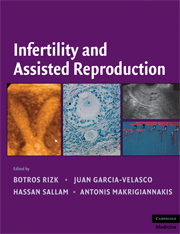Book contents
- Frontmatter
- Contents
- Contributors
- Foreword
- Preface
- Introduction
- PART I PHYSIOLOGY OF REPRODUCTION
- PART II INFERTILITY EVALUATION AND TREATMENT
- PART III ASSISTED REPRODUCTION
- PART IV ETHICAL DILEMMAS IN FERTILITY AND ASSISTED REPRODUCTION
- 69 Stem Cell Research
- 70 Fertility Preservation in Female and Male Cancer Patients
- 71 Ethical Dilemmas in ART: Current Issues
- 72 Infertility Treatment in Perimenopausal Women: Ethical Considerations
- 73 Religious Perspectives of Ethical Issues in Inferility and ART
- 74 The Future of Assisted Reproduction
- Index
- Plate section
- References
74 - The Future of Assisted Reproduction
from PART IV - ETHICAL DILEMMAS IN FERTILITY AND ASSISTED REPRODUCTION
Published online by Cambridge University Press: 04 August 2010
- Frontmatter
- Contents
- Contributors
- Foreword
- Preface
- Introduction
- PART I PHYSIOLOGY OF REPRODUCTION
- PART II INFERTILITY EVALUATION AND TREATMENT
- PART III ASSISTED REPRODUCTION
- PART IV ETHICAL DILEMMAS IN FERTILITY AND ASSISTED REPRODUCTION
- 69 Stem Cell Research
- 70 Fertility Preservation in Female and Male Cancer Patients
- 71 Ethical Dilemmas in ART: Current Issues
- 72 Infertility Treatment in Perimenopausal Women: Ethical Considerations
- 73 Religious Perspectives of Ethical Issues in Inferility and ART
- 74 The Future of Assisted Reproduction
- Index
- Plate section
- References
Summary
The past three decades have witnessed revolution in reproductive medicine. Since the birth of Louise Brown in 1978 (1), there has been an expansion in the number of vitro fertilization treatment worldwide. In the first European Register publication (2) 203,893 IVF/ICSI were reported by eighteen European countries, and by 2002, this number rose to 324,238 cycles from twenty-five countries, accounting for almost 60 percent increase of registered cycles (3). In the last World IVF report from 2000, 460,157 cycles were carried out in forty-nine countries, and it was estimated that approximately 200,000 babies were born (4). Although neither European nor World coverage is complete regarding the register data, the expansion of IVF is evident, and the estimate is that more than three million children have been born as a result of assisted reproduction since the beginning.
The driving force of this medical field has always been better treatment outcome. Increasing the efficiency of the treatment is what the future holds for us.
DEFINITION OF SUCCESS
What is the definition of success in assisted reproduction? A debate was started in Human Reproduction in 2004, with the suggestion of Min et al., to define success as “BESST – birth emphasizing a successful singleton at term” (5). This sparked discussion of many renowned international groups, and a number of definitions were introduced – healthy lower order birth (6), number of elective single embryo transfers per center (7), and value of cryopreservation programs (8).
Keywords
- Type
- Chapter
- Information
- Infertility and Assisted Reproduction , pp. 747 - 758Publisher: Cambridge University PressPrint publication year: 2008



